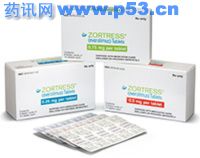|
近日,FDA批准由诺华制药公司生产的依维莫司(everolimus)片(商品名Zortress)可与小剂量环孢素、巴利昔单抗以及皮质类固醇药物联合使用,用于预防伴有低度至中度免疫风险的成人肾移植患者的器官排异反应。该药通过与哺乳动物雷帕霉素靶点(mTOR)结合,抑制抗原激活T细胞增殖,从而达到免疫抑制效果。目前,依维莫司已在美国以外的70多个国家被批准用于肾和心脏移植的药物治疗。 支持此项批准的3期试验显示,Zortress预防器官排异与保护肾功能,同时与使用麦考酚酸相比降低了60%的环孢菌素使用量,显示使用Zortress可在保持同样效果下降低使用钙调素抑制剂产生的副作用。 ZORTRESS Indication(s):Organ rejection prophylaxis in renal transplant patients with low-moderate immunologic risk, in combination with basiliximab induction and reduced doses of cyclosporine and corticosteroids. Pharmacology:Everolimus binds to the cytoplasmic protein, FK506 Binding Protein-12, forming a complex that binds to and inhibits the mammalian target of rapamycin (mTOR). This interaction inhibits p70 S6 ribosomal protein kinase activity, resulting in inhibition of ribosomal S6 protein phosphorylation, subsequent protein synthesis and cell proliferation. This action consequently inhibits antigenic and interleukin (IL-2 and IL-15) stimulated activation and proliferation of T and B lymphocytes. Clinical Trials:A 24-month, multinational, open-label, randomized trial, involving 833 de novo renal transplant patients 18–70 years of age, evaluated everolimus 1.5mg/day or everolimus 3mg/day plus reduced doses of cyclosporine and corticosteroids to 1.44g/day mycophenolic acid plus standard doses of cyclosporine and corticosteroids. At 12 months, everolimus 1.5mg/day was shown to be comparable to mycophenolic acid with respect to efficacy failure (25.3% and 24.2%, respectively), defined as treated biopsy-proven acute rejection, graft loss, death or loss to follow-up. Additionally, the calculated mean glomerular filtration rate (GFR) for everolimus 1.5mg/day and mycophenolic acid were comparable at month 12 (54.6mL/min and 52.3mL/min, respectively). Two multicenter, double-blind (for first 12 months), randomized trials enrolling 1171 total de novo renal transplant patients compared fixed doses of everolimus 1.5mg/day and 3mg/day combined with standard doses of cyclosporine and corticosteroids to mycophenolate mofetil 2g/day and corticosteroids. The 12-month analysis of GFR demonstrated increased rates of renal impairment in both everolimus groups compared to the mycophenolate mofetil group in both trials. Therefore, cyclosporine doses should be reduced when used in combination with everolimus, and everolimus trough concentrations should be adjusted and maintained between 3 to 8ng/mL using therapeutic drug monitoring. Legal Classification:Rx Adults:Give as soon as possible after transplantation. Swallow whole. ≥18yrs: Initially 0.75mg every 12 hours (1.5mg/day) in combination with reduced dose cyclosporine. May adjust dose at 4–5 day intervals to achieve everolimus trough concentration target range: 3–8ng/mL. Moderate hepatic dysfunction: reduce daily dose by 1/2 the initial daily dose. Initiate oral prednisone as soon as oral medication is tolerated. Children:<18yrs: not recommended. Contraindication(s):Sirolimus allergy. Precaution(s):Increased risk of infections, lymphomas and other malignancies (eg, skin). Avoid sun, UV light. High immunologic risk or prophylaxis in other organs: not established. Severe hepatic impairment or hereditary disorders (eg, galactose intolerance, Lapp lactase deficiency, glucose-galactose malabsorption): not recommended. Diabetes. Obtain everolimus and cyclosporine (see literature) whole blood concentrations periodically; and trough concentrations during dose adjustments. Monitor CBCs, renal function, urine protein, lipids, blood glucose, and for pneumonitis and infections. Pregnancy (Cat.C); use effective method of contraception during and up to 8 weeks after therapy. Nursing mothers: not recommended. Interaction(s):Avoid live vaccines, standard doses of cyclosporine. Increased risk of angioedema with ACE-inhibitors. Potentiated by CYP3A4 and/or P-glycoprotein inhibitors; avoid strong inhibitors (eg, ketoconazole, itraconazole, voriconazole, clarithromycin, telithromycin, ritonavir, grapefruit juice, digoxin); monitor and adjust dose with moderate inhibitors (eg, erythromycin, fluconazole, nicardipine, diltiazem, nelfinavir, indinavir, amprenavir), or CYP3A4 and P-glycoprotein substrate (eg, verapamil). Antagonized by CYP3A4 inducers (eg, carbamazepine, phenobarbital, phenytoin, efavirenz, nevirapine, St. John’s Wort); avoid strong inducers (eg, rifampin, rifabutin). Avoid simvastatin, lovastatin; monitor if used with atorvastatin or pravastatin. Caution with other nephrotoxic drugs, CYP3A4 or CYP2D6 substrates with a narrow therapeutic index. Adverse Reaction(s):Peripheral edema, GI upset, constipation, hypertension, anemia, infections (eg, UTI), hyperlipidemia, angioedema, malignancies (eg, lymphomas, skin), proteinuria, nephrotoxicity, graft thrombosis, delayed wound healing/dehiscence, polyoma virus infections (eg, BK virus-associated nephropathy), non-infectious pneumonitis (reduce or interrupt dose and/or manage with corticosteroids), thrombotic microangiopathy, thrombotic thrombocytopenic purpura, hemolytic uremic syndrome, new-onset diabetes post-transplant, male infertility. How Supplied:Tabs—60 (10 x 6 blister strips) Last Updated:7/22/2010 制造商: 类药物: 活性成分(补): 适应症(补): 药理: 临床试验: 两个多中心,双盲的头12个月(),随机试验,纳入1171年总从头肾移植患者相比,固定剂量的everolimus的1.5mg/day和3mg/day环孢素和皮质类固醇与标准剂量霉酚酸酯2g/day结合和皮质类固醇。对GFR的12个月的分析表明这两个群体的everolimus的肾功能损害率增加相比,霉酚酸酯组在这两个试验。因此,应减少剂量环孢素使用时与everolimus的结合,everolimus的谷浓度应进行调整,维持在3至8ng/mL使用的治疗药物监测。
成人: 儿童: 禁忌(补): 注意事项(补): 互动(补): 不良反应(补): 如何提供: 最后更新: 美国FDA于2009年3月30日批准Novartis(诺华)公司的依维莫司片(Everolimus Tablets,商品名:Afinitor。)用于已采用舒尼替尼或索拉非尼治疗无效的晚期肾细胞癌患者。该药于2003年首次在瑞典上市,2007年10月14日在欧洲被批准用于治疗胃肠胰腺神经分泌瘤。 |
FDA批准Zortress(依维莫司片)用于治疗肾移植排异反应简介:
近日,FDA批准由诺华制药公司生产的依维莫司(everolimus)片(商品名Zortress)可与小剂量环孢素、巴利昔单抗以及皮质类固醇药物联合使用,用于预防伴有低度至中度免疫风险的成人肾移植患者的器官排异 ... 责任编辑:admin |
最新文章更多推荐文章更多热点文章更多 |


